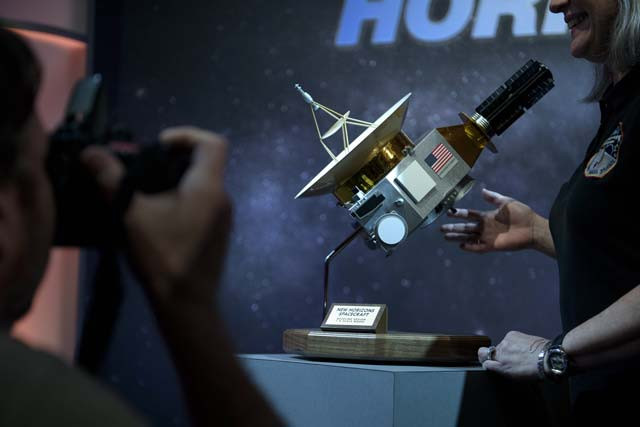US spacecraft whizzes by Pluto in historic flyby
The photos will reveal details of Pluto never seen before in the history of space travel

People pose with a model of the New Horizons probe at the Johns Hopkins University Applied Physics Laboratory July 14, 2015 in Laurel, Maryland. PHOTO: AFP
Moving faster than any spacecraft ever built at a speed of about 30,800 miles per hour (50,000 kph), the nuclear-powered New Horizons -- about the size of a baby grand piano -- snapped pictures of Pluto as it hurtled by on auto-pilot.
 This artist’s impression shows the New Horizons spacecraft as it approaches Pluto and its largest moon. PHOTO: AFP
This artist’s impression shows the New Horizons spacecraft as it approaches Pluto and its largest moon. PHOTO: AFPThe photos will reveal details of Pluto never seen before in the history of space travel.
"The New Horizons spacecraft passes its closest approach mark at Pluto after a three-billion-mile journey," a NASA commentator said as spectators waved flags in a crowded room at the Johns Hopkins Applied Physics Center outside the US capital Washington.
The spacecraft was a bit closer to Pluto's surface than initially planned, 7,750 miles -- or about the distance from New York to Mumbai, India -- and may have been one minute earlier than the 1149 GMT target time, the US space agency said.
"I have to pinch myself. Look what we accomplished," mission operations manager Alice Bowman said.
 This NASA photo shows guest and New Horizons team members as they countdown to the spacecraft's closest approach to Pluto, July 14, 2015 at the Johns Hopkins University Applied Physics Laboratory (APL) in Laurel, Maryland. PHOTO: AFP
This NASA photo shows guest and New Horizons team members as they countdown to the spacecraft's closest approach to Pluto, July 14, 2015 at the Johns Hopkins University Applied Physics Laboratory (APL) in Laurel, Maryland. PHOTO: AFP"It is truly amazing that humankind can go out and explore these worlds. And to see Pluto be revealed just before our eyes -- it is just fantastic."
New Horizons principal investigator Alan Stern described what he called "a moment of celebration," with the promise of a "16-month data waterfall" ahead that will help scientists write whole new textbooks about Pluto.
"We have completed the initial reconnaissance of the solar system, an endeavor started under President (John F.) Kennedy more than 50 years ago, continuing today under President (Barack) Obama," Stern told reporters.
YES! After over 9 years & 3+ billion miles, @NASANewHorizons #PlutoFlyby was at 7:49am ET. http://t.co/Czrvonxugd pic.twitter.com/aSucgORofT
— NASA (@NASA) July 14, 2015
Never before has a spacecraft ventured into the Kuiper Belt, and New Horizons has been on its way there for more than nine years.
The spacecraft launched in 2006, the same year that Pluto was downgraded to "dwarf planet" status due to the celestial body's small size.
New Horizons is the first spacecraft to fly past Pluto and its seven scientific instruments aim to reveal up-close details of the surface, geology and atmosphere of Pluto and its five moons.
Already, scientists have learned from New Horizons that Pluto is 20-30 kilometers larger than previously thought, with a radius of 736 miles.
Scientists have also confirmed the existence of a polar ice cap on Pluto and found nitrogen escaping from Pluto's atmosphere.
"This is truly a hallmark in human history," said NASA's head of the science mission directorate, John Grunsfeld.
The spacecraft has enough fuel to carry on its exploration for years to come.
Stern plans to ask NASA for funding to continue using New Horizons beyond its Pluto mission.
But first scientists need to know if it survived the chaotic Kuiper Belt, the region beyond Neptune which Stern has described as a "shooting gallery" of cosmic debris.
"A collision with a particle as small as a grain of rice could incapacitate the spacecraft," NASA said in a statement.
 Dr Allan Stern (L), principal investigator for the New Horizons mission to Pluto, and others hold up their suggestion for a modified US Post Office stamp of Pluto at the Johns Hopkins University Applied Physics Laboratory on July 14, 2015. PHOTO: AFP
Dr Allan Stern (L), principal investigator for the New Horizons mission to Pluto, and others hold up their suggestion for a modified US Post Office stamp of Pluto at the Johns Hopkins University Applied Physics Laboratory on July 14, 2015. PHOTO: AFPNASA expects to receive a signal from the spacecraft at 9:02 pm (0102 GMT Wednesday) to find out whether or not the spacecraft made it through intact.
Experts said there was a one in 10,000 chance that the spacecraft could be lost in a debris strike.
"I am feeling a little bit nervous just like you do when you send your child off," said Bowman.
"But I have absolute confidence that it is going to do what it needs to do and it is going to turn around and send us that burst of data and tell us that it is okay."



















COMMENTS
Comments are moderated and generally will be posted if they are on-topic and not abusive.
For more information, please see our Comments FAQ